Ah, the holidays.
That magical time of year when lights twinkle, bells jingle, and travels begin to mingle.
But—
Where’s everyone headed for this year’s Christmas holiday season? How are they getting there?
To find out this and much more, PhotoAiD surveyed over 1,000 Americans, and we’ve got the scoop for you.
Let’s dig in:
Key Takeaways
- Most people (37%) plan to spend 4–7 days away from home during Christmas.
- About 48% of respondents plan to travel domestically, while fewer consider international travel (27%) or a combination of both (22%).
- Roughly 65% of Americans have a budget of $1,001 or more for the Christmas holiday season this year.
- Due to current economic conditions, most respondents will travel for fewer days (23%) or reduce travel distances (18%).
- A significant 57% of survey takers foresee some holiday debt post-travels.
- Nearly 66% of Americans are somewhat (46%) or extremely (20%) concerned about Christmas travel.
- Family dynamics (25%) and weather conditions (24%) are travelers’ primary concerns.
Preferred Planning Windows, Mode of Transportation, Travel Duration, and More
Did you know?
Prices for Christmas trips have plunged by $40 on average since summer.
But—
While airfares will stay relatively low until the end of October, they’re set to climb in November and December.
So much so that last-minute bookers may see prices surge by over $40 per day in the final week before Christmas departures.
Given these dynamics, we got curious:
How far ahead do people plan their festive journeys?
Below are the results:
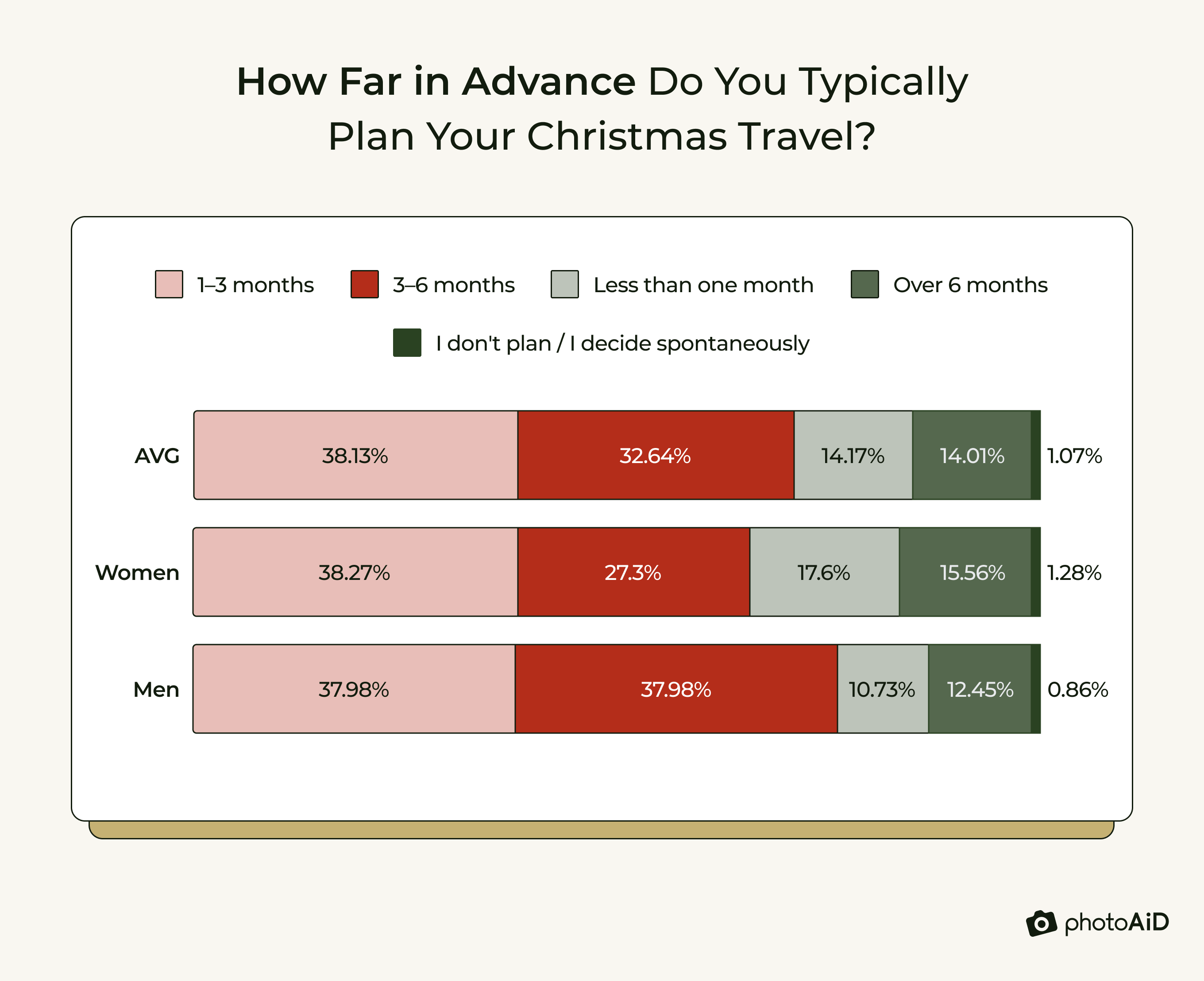
The data suggests that 1–3 months out is the preferred planning window for Christmas travel, with 38% of respondents choosing this option. A gender dive also shows that men are keener on a 3–6 month lead time than women: 38% vs. 27%.
A word to the wise? Book early.
Now—let’s talk distance.
That is, how far Americans are willing to traverse for the upcoming holiday season cheer.
| Approximately How Far Will You Travel for the Christmas Holiday Season This Year from Your Home (in Miles)? | Share |
|---|---|
| 201–500 | 29.12% |
| More than 500 | 24.48% |
| 101–200 | 21% |
| 50–100 | 15.43% |
| Less than 50 | 6.84% |
A sizable 29% plan to cover between 201 and 500 miles, likely chasing family gatherings or unique holiday experiences.
It’s followed by 24% of Americans geared up to cover distances exceeding 500 miles, hinting at long-haul or international travel.
What will be the favored mode of transportation?
Let’s find out:
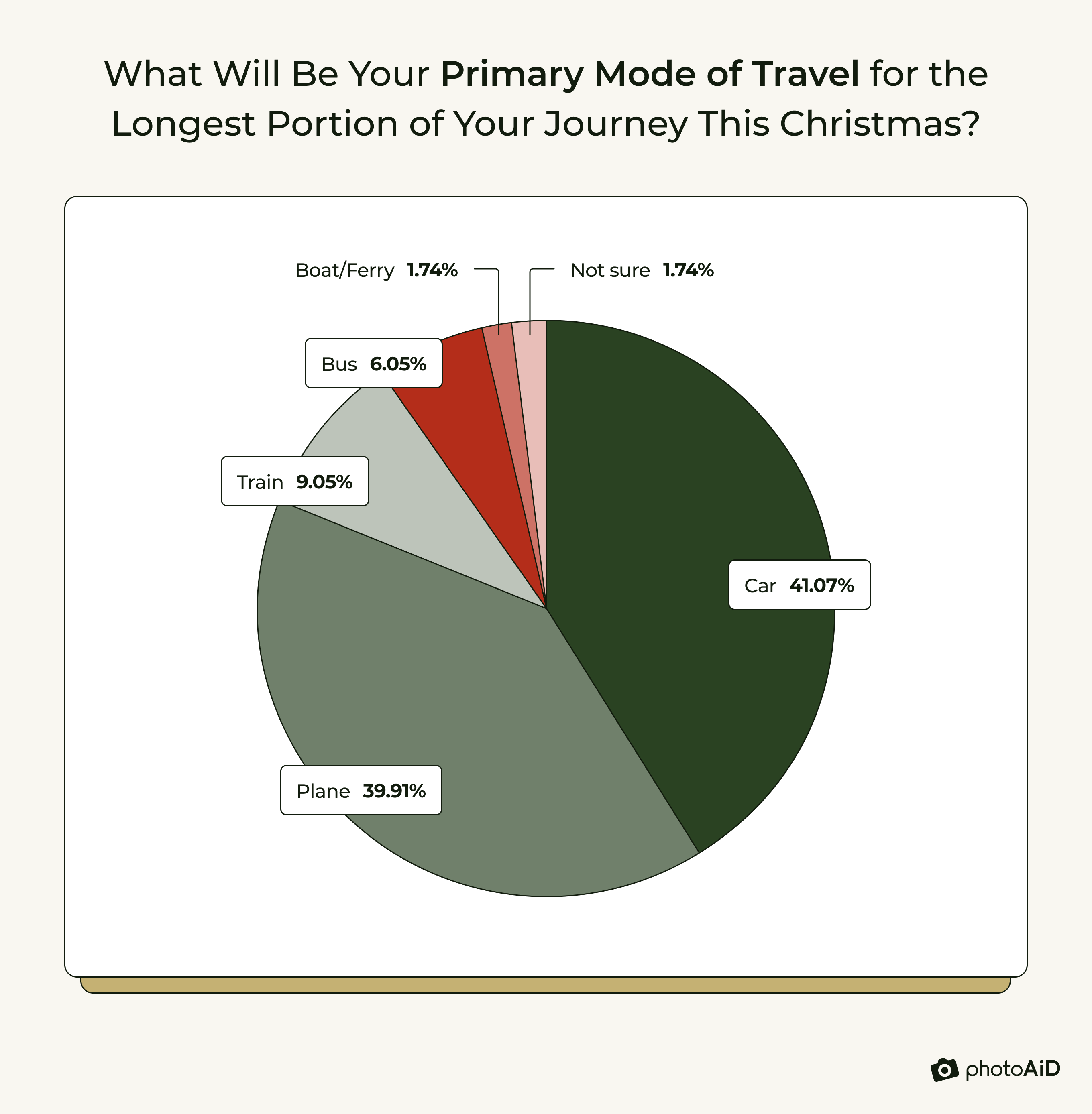
Our intel reveals clear winners: cars (41%) and planes (40%). Combined, these modes claim the votes of 81% of respondents.
Makes sense.
Lastly, we sought to determine how long Americans would hang up their “Out of Office” signs.
The results are in:
| How Long Will Your Christmas Trip Be? | AVG | Women | Men | Gen Zers | Millennials | Gen Xers | Baby Boomers |
|---|---|---|---|---|---|---|---|
| 4–7 days | 37.18% | 41.58% | 34.98% | 44.16% | 35.64% | 35.37% | 31.37% |
| 1–3 days | 27.06% | 23.47% | 29.61% | 26.28% | 24.87% | 32.65% | 25.49% |
| 8–14 days | 22.21% | 20.41% | 25.54% | 19.71% | 26.92% | 21.09% | 19.61% |
| More than 14 days | 9.93% | 9.95% | 8.37% | 6.2% | 10.51% | 8.84% | 15.69% |
The predominant pick is four to seven days, with 37% opting for this duration. Interestingly, women sway toward the week-long breather more than men: 42% vs 35%.
Generational preferences are also intriguing.
Zoomers lead the week-long vacation charge at 44%. Millennials oscillate, with 27% leaning towards 8–14 days. Gen Xers showcase a penchant for quick getaways, with 33% banking on 1–3 days.
And Baby Boomers?
They’re out to savor the season, with 16% planning over 14 days away.
With this, let’s proceed to our next segment.
From NYC to Tokyo: Top Holiday Destinations This Season
Let’s tackle the big question:
As the jingle bells ring and snowflakes fall, how do Americans plan to travel for the Christmas holiday season this year?
The numbers are in:
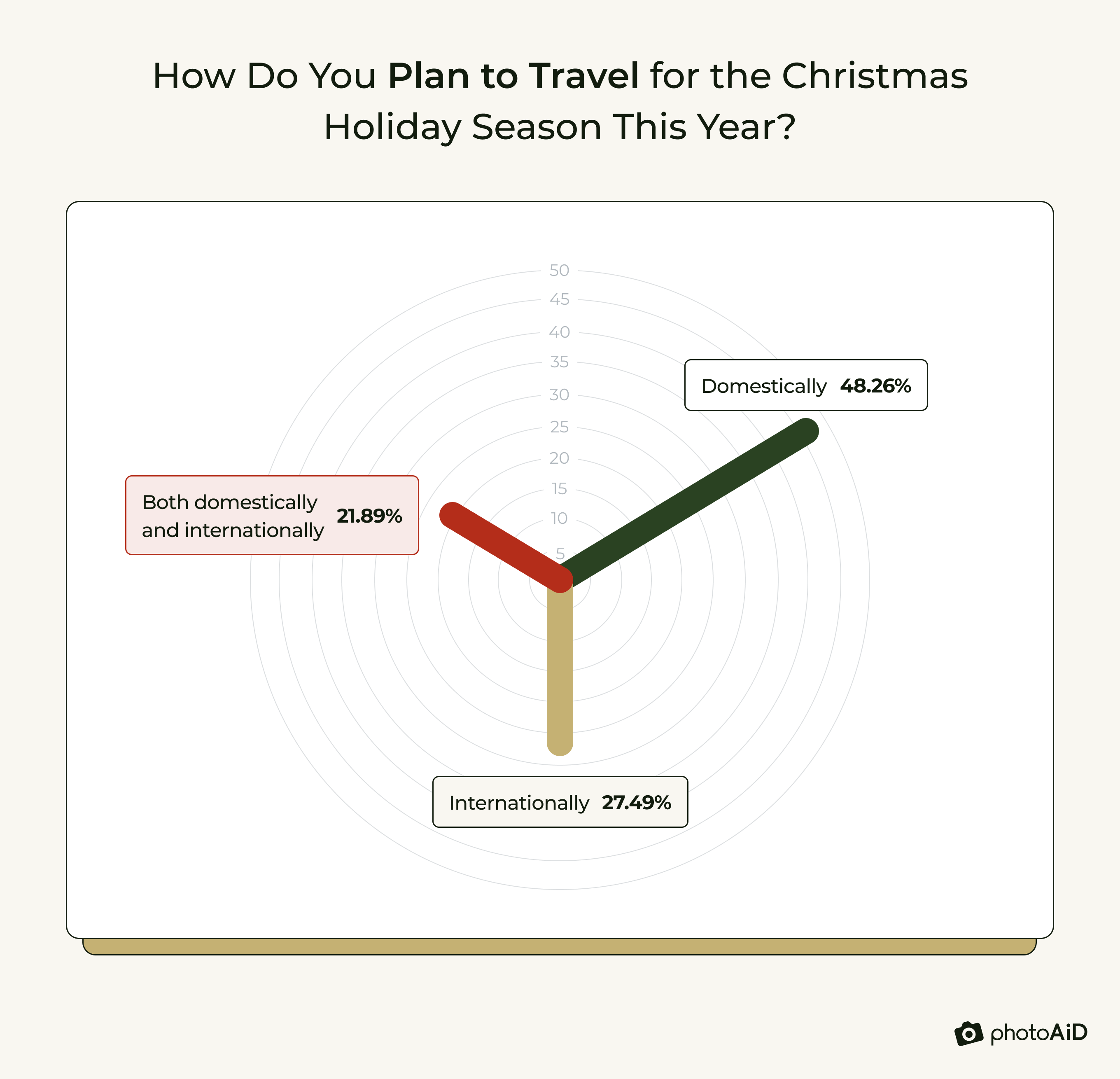
About 48% of respondents have chosen the domestic route.
Perhaps convenience, the comfort of the familiar, and the ever-changing global landscape influenced these choices.
But where exactly are people headed?
Using data from Hopper, below are the most popular places for Christmas 2023:
| Top Domestic Destinations for Christmas | Top International Destinations for Christmas |
|---|---|
| 01. New York City | 01. Tokyo |
| 02. Orlando | 02. London |
| 03. Los Angeles | 03. Paris |
| 04. Las Vegas | 04. Shanghai |
| 05. Denver | 05. Mexico City |
With its iconic Christmas tree at Rockefeller Center and enchanting window displays, New York City took the top spot.
But—globally, it’s Tokyo that’s winning hearts.
Next, we’ll delve into the financial side of these festive journeys.
Nearly 6 in 10 Americans Expect Some Holiday Debt Post-travels
Travel has become more expensive.
Why?
It’s a combination of pent-up demand and the ripple effects of the pandemic. Everyone wants to make up for the lost time.
But there’s more.
While inflation is retreating, it still lingers. This raises prices in the travel sector, from worker wages to hotel amenities, which consumers eventually bear.
As a result, travel costs have increased by 9% over the past year and a full 20% since 2019, according to NerdWallet.
Given this backdrop, we wanted to see how Americans’ travel budgets look for the upcoming holiday season.
Let’s have a look:
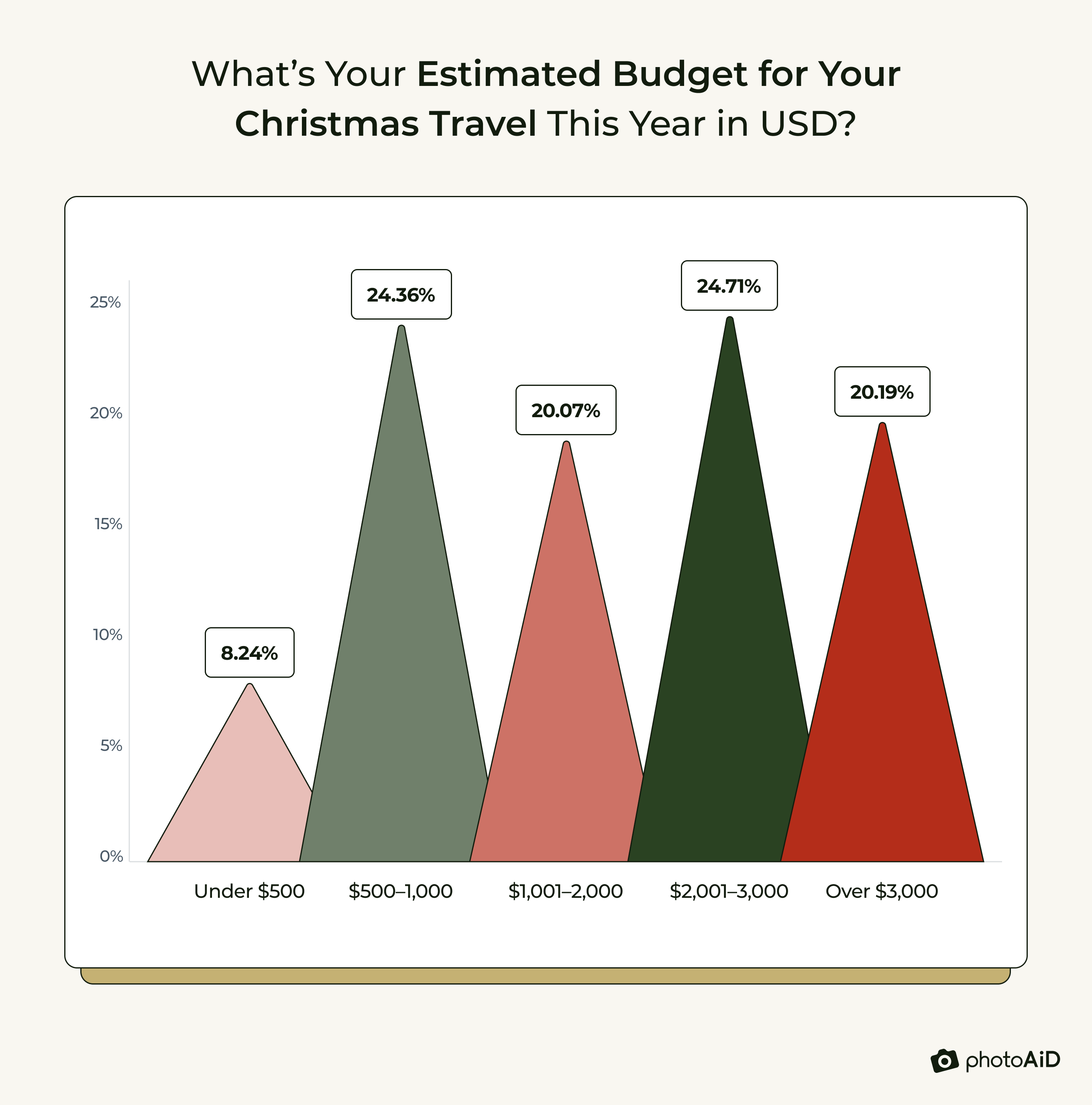
The data suggests that 65% of survey takers have a budget of $1,001 or more.
Has today’s economy influenced these travel decisions?
Indeed.
| Have Current Economic Conditions, Such as Inflation, Affected Your Christmas Travel Plans? | Share |
|---|---|
| Yes | 64.39% |
| No | 35.61% |
As you can tell, about 64% adjusted their plans due to economic tides.
Here’s what it means in practice:
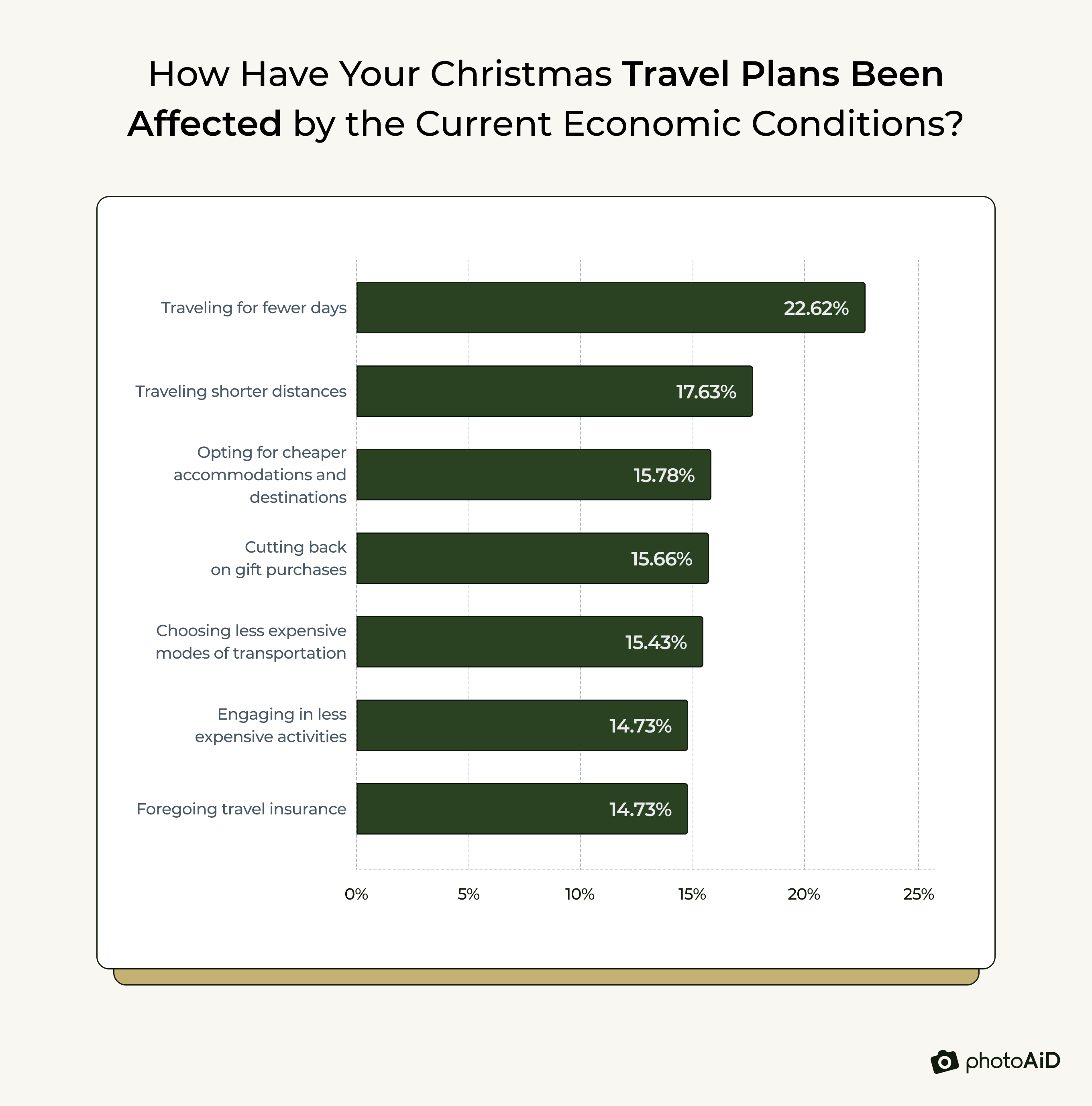
According to our data, the top affected areas are the duration of the travel and the distance traveled, with 23% and 18%, respectively.
This shows that people rethink the heart of their plans when the going gets tough economically.
Considering this, it’s unsurprising that over half (57%) also foresee some holiday debt post-travels.
Take a look:
| Do You Anticipate Going into Debt Due to Travel for the Christmas Holiday Season This Year? | Share |
|---|---|
| Yes | 56.73% |
| No | 28.07% |
| Not sure | 15.2% |
It’s a reminder of the lengths we’ll go to for the magic of the season. But as with everything, balance is key.
So—
Travel wise, spend smart.
Family Dynamics and Unpredictable Weather Conditions Worry People the Most
Crowded airports. Lost luggage. Tight schedules.
Travel can get your heart racing.
In fact, a recent study by Passport Photo Online found that 92% of Americans find travel nerve-racking.
So—
How are these nerves holding up for the forthcoming Christmas holiday season?
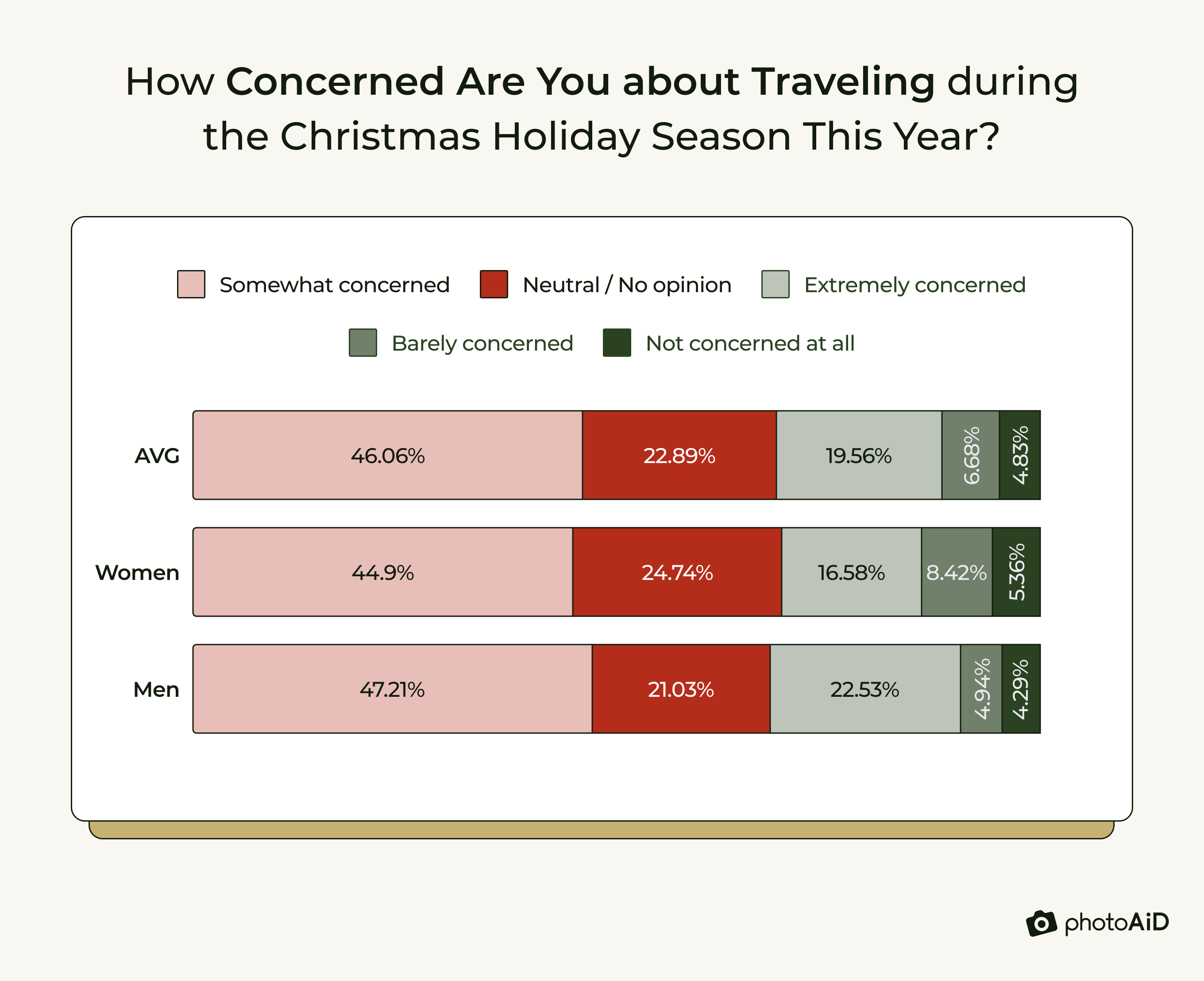
As you can see, 66% of respondents are somewhat (46%) or extremely (20%) concerned about hitting the road or skies this Christmas.
Interestingly, ladies seem slightly less jittery.
With 61% of women expressing they’re somewhat or extremely concerned, they trail the men at 70%. Maybe it’s because women have the edge in handling stressful conditions, according to Psych Central research.
Regardless, here’s what concerns travelers:
| What’s Your Primary Concern When Traveling for the Christmas Holiday Season This Year? | Share |
|---|---|
| Family dynamics | 24.59% |
| Weather conditions | 23.67% |
| Transportation issues (e.g., flight delays, traffic) | 15.89% |
| Accommodation availability | 14.5% |
| Costs | 9.74% |
| Crowds | 7.77% |
Top of the list?
Family dynamics at 25%, closely followed by weather worries at 24%.
Whether it’s the potential for old family squabbles to resurface or the unpredictability of weather, Christmas travelers have their plate full of concerns this year.
But—
It’s not all doom and gloom.
In our next section, we’ll explore America’s favorite Christmas traditions to leave you feeling warm and fuzzy.
Spending Time with Family/Friends: The Top Choice for This Year’s Festivities
Be it the fragrance of freshly baked cookies, the hum of carols, or the sparkle of lights, we all have that one tradition we eagerly await.
So, what’s on the top of everyone’s list this year?
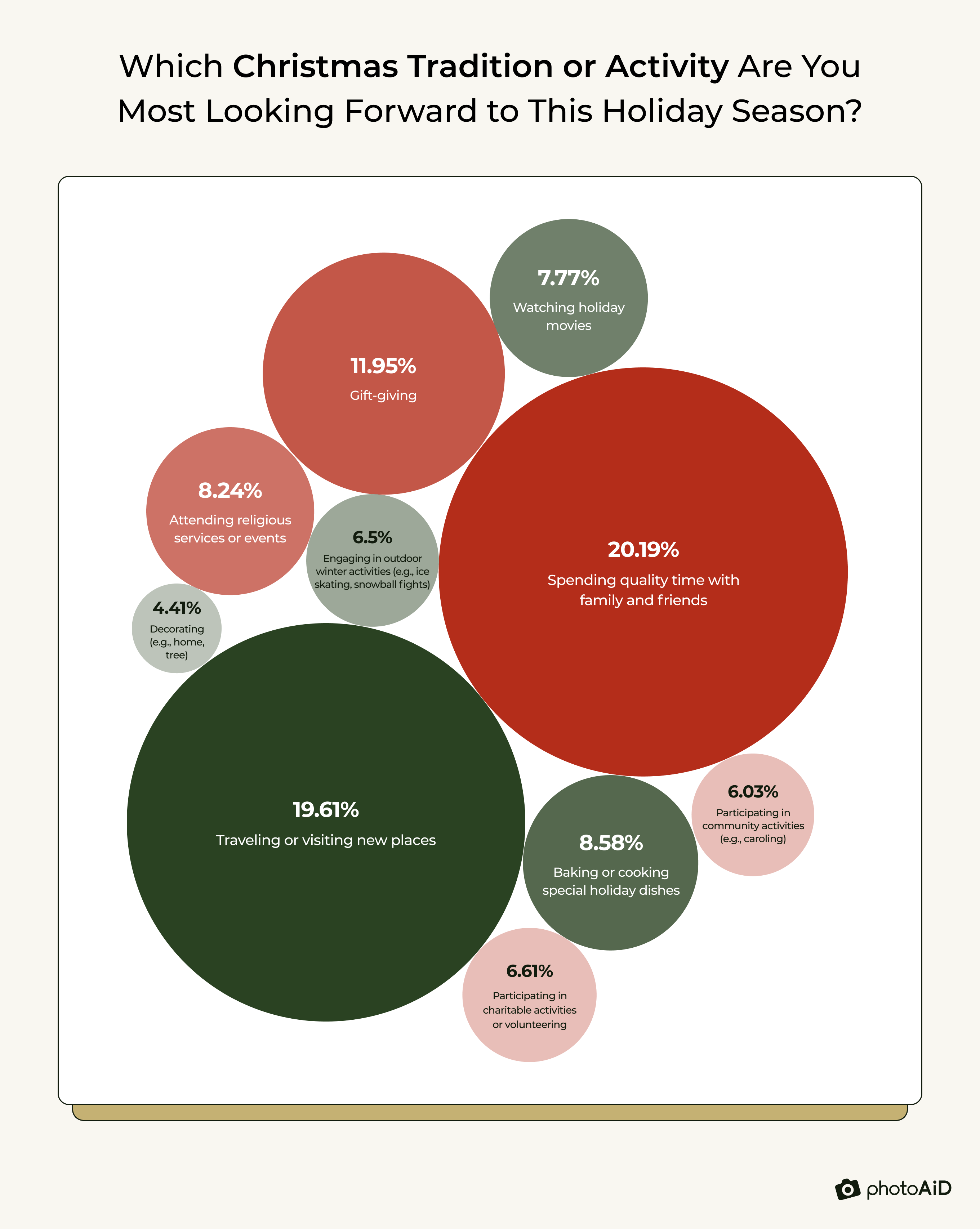
Over 20% have set their sights on embracing those snug, heartfelt moments with loved ones. Whereas a close 19.61% are ready to venture into new territories or revisit familiar places.
Now—
As the countdown begins and excitement brews, here’s hoping your holiday moments are as delightful as your favorite Christmas cookie.
Safe travels!
Stacking It All Up
There you have it.
A comprehensive look at Americans’ travel plans for the Christmas holiday season in 2023.
Now—
If you believe your audience will be interested in this information, feel free to share it. Just remember to mention the source and link back to this page.
Methodology
We conducted an online survey of 1,019 US respondents (who had traveled in the past 36 months and had been primarily or jointly responsible for travel planning) via a bespoke online polling tool in October 2023.
The respondents were 54.1% male, 45.5% female, and 0.5% identified as other. 31.8% of respondents were 26 or younger, 45.2% were aged 27–42, 17.1% were aged 43–58, and 5.9% were 59 or older.
This survey has a confidence level of 95% and a margin of error of 3%. Given the gender and age makeup of our sample size, the study’s findings are statistically significant for the population at large.
This study was created through multiple research steps, crowdsourcing, and surveying. Data scientists reviewed all survey participants’ responses for quality control. The survey also had an attention-check question.
Sources
- CNBC, “Travel Costs Are ‘Off the Charts,’ Experts Say. Here’s How to Save”
- Hopper, “2023 Holiday Travel Outlook”
- HuffPost, “Women Handle Stress Better? Estrogen May Be Why, New Study Suggests”
- NerdWallet, “Travel Inflation Report”
- Passport Photo Online, “What Stresses Americans The Most When Traveling?”

As a Digital PR specialist and a member of the Society of Professional Journalists (SPJ), I have 5+ years of writing experience.
Over the course of my career, my work has garnered significant attention, with features in numerous prominent publications such as The New York Times, Forbes, Inc., Business Insider, Fast Company, Entrepreneur, BBC, TechRepublic, Glassdoor, and G2.









